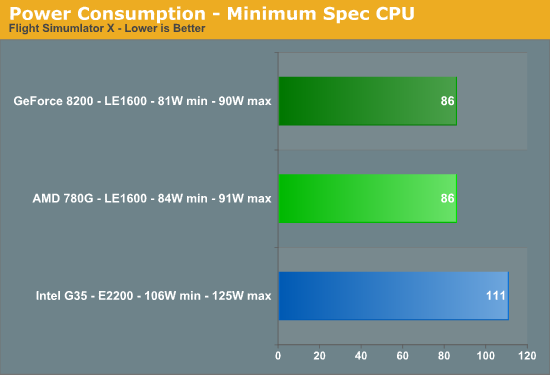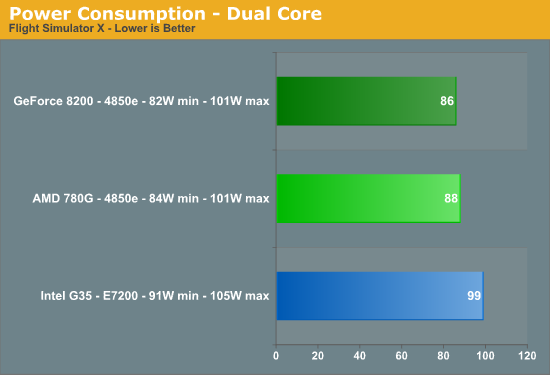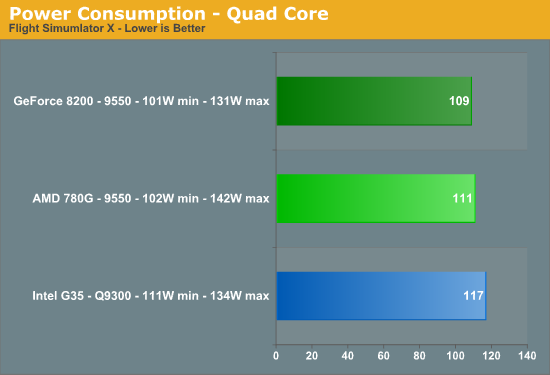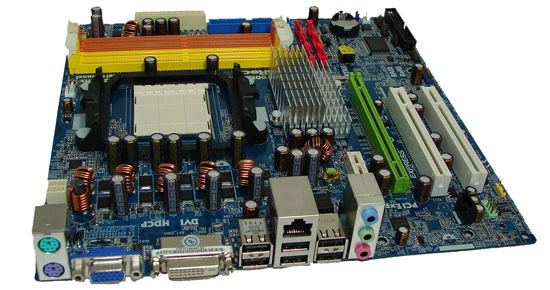IGP Power Consumption - 780G, GF8200, and G35
by Gary Key on April 18, 2008 2:00 AM EST- Posted in
- CPUs
Flight Simulator X Test
Whether playing Solitaire since the Windows 3.0 days or flying around your favorite locale in the longest running series on the PC, casual gaming on the PC is an activity just about everyone with a PC has done at one time or another. Our test today consists of a flight around the Honolulu harbor area and is something all three chipsets can handle, with the appropriate settings and resolutions. The actual winner is the 780G chipset, but what we are concerned about is how many dollars your electric company will collect when you relax and play a game.



We listed minimum and maximum voltages during our six-minute trip around the harbor, but the charts show the average. The current version of Flight Simulator X with the Acceleration Pack is fully multi-core aware and provides a workout for both the CPU and GPU as you crank up the settings. Our AMD LE1600 is a single-core CPU so the voltage variations are not as great compared to the multi-core CPUs. This processor stayed near the 100% utilization level during FSX testing, although frame rates did not seem to suffer that much at our 1024x768 medium settings.
The results are closer this time around between our two AMD platform chipsets. The GeForce 8200 once again finishes slightly in the lead but our upcoming gaming tests will show it following in the footsteps of the AMD 780G. The results are a tie between the AMD chipsets but a 25W advantage over G35 with the low-end processors, a 2W and 13W improvement with the dual cores, and a soft landing with 2W and 8W differences between the quad cores.

First Thoughts
We told you it would be a short article. However, we think the results today should provide a better indication to each platform's power requirements with a variety of CPUs likely to end up in these boards and applications that tend to stress those same processors. Unless the next NVIDIA driver set increases power consumption, then we have a surprise winner between the latest IGP chipsets from the big three. The next question we will answer is performance per watt and those results are likely to lead us down another path.
The power bill savings alone are not that large, of course. Running 24/7, 365 days per year, a 10W power difference works out to 87.6 kWh of energy over the course of a year. At a rate of 10 cents per kWh, that would work out to less than a dollar per month. In the bigger picture, however, the 5W to 25W difference between chipsets or platforms can be far more meaningful. If you want a silent - or at least very quiet - PC, every watt saved can be meaningful. Cooler running chipsets can also avoid the need for "noisy cricket" fans or monstrous cooling configurations. All other things being equal, we would definitely prefer less power-hungry components.










44 Comments
View All Comments
wjl - Sunday, April 27, 2008 - link
If you own a decent mainboard and processor (meaning anything newer than AMD K7 or Intel P4), I think it's mostly the power supply which can help with efficiency.Building my AMD X2 3800+ EE into a bigger case with an 80+ certified power supply (and 90+ is coming soon as well, according to DigiTimes) helped reducing the idle power cosumption from 89W (with one hard disk and TV card) to some 74W (now with two hard disks and TV cards).
New main boards and single platter hard disks may help, but it's normally better to look at the weak points of your current systems IMHO.
hian001 - Wednesday, May 22, 2013 - link
Penetration Testing A standard penetration test is a way for scientists to get an idea of how resistant the soil in a certain area is to the invasion of water. The tests conducted on the sample are usually unaffected by the disturbance of the soil. <a href="http://www.breaksec.com/">Penetration Testing</a>computerfarmer - Wednesday, April 23, 2008 - link
It is good to see this kind of information. Lower power consumption has its place considering the cost, those that pay the bills will understand. I am looking forward to the 780G roundup, if it includes the 8200, that's good too.Keep up the excellent work.
bingbong - Tuesday, April 22, 2008 - link
Ok Thanks to those who said it is available. I will try the vendors again. I have only been looking online because I tried to buy it a couple of times. Actually I am in Taiwan so the availability is usually pretty good.l8r
sheh - Monday, April 21, 2008 - link
This recent power efficiency trend is something I definitely like. At this rate, and with Atom coming, it might be possible to run a decent general-purpose computer on a <200W PSU.*cleans up the AT PSU*
smilingcrow - Sunday, April 20, 2008 - link
I’ve tested a couple of systems with different Gigabyte G35 boards with various 65nm C2Ds and idle power consumption averaged around 55W with a spec similar to yours; only 2x1GB of RAM though. SPCR tested the exact same Asus board and managed no worse than 56W at idle although that was with a lesser spec and older less efficient E6400. This makes me wonder how you managed to record 84W at idle with an E2200 when I managed 52.5W with an E2140!wjl - Sunday, April 20, 2008 - link
Yeah, exactly. My wife's machine (G35, E8200, 2Gig RAM, and a Samsung F1 750) draws some 69W on idle when in Gnome / Debian Lenny - and that is reported to take more than anything M$. The power supply used here is an EarthWatts (Seasonic) 500W 80+, which seems to be ok even at those low levels.My own one for comparison: AMD X2 3800+ EE on Nvidia 6150/430, 3Gig, 2x250Gig, 380W EarthWatts 80+ - takes also 69 Watts in its best moments (Gonme / Debian Etch, which doesn't have something like cpufreqd yet), tho here the "average" idle is more like 75W.
cheers,
wjl
smilingcrow - Monday, April 21, 2008 - link
I emailed the author about the G35 power data as it seemed disproportionately high and was skewing the results; he didn’t reply but the G35/E2200 at idle data has now been reduced from 84 to 74W with no reference being made to the change!smilingcrow - Monday, April 21, 2008 - link
In a previous article by the same author http://www.anandtech.com/cpuchipsets/showdoc.aspx?...">http://www.anandtech.com/cpuchipsets/showdoc.aspx?... he looked at the same Asus G35 & Gigabyte 780G boards but compared them against an Asus GF8200 board and made the following comment:“As far as power consumption goes during H.264 playback, the AMD platform averaged 106W, NVIDIA platform at 102W, and the Intel platform averaged 104W - too close to really declare a true winner.”
The same CPUs were used so some consistency might be expected between that review and the current one, but if the power data for H.264 decoding is compared we get this:
Old / New / Difference (Watts)
GF8200 – 102 / 77 / 25
780G – 106W / 84 / 22
G35 – 104W / 103 / 1
Somehow the G35 platform seemed to gain 21 to 24W of power consumption compared to the two AM2+ platforms. Is this purely down to the higher bit-rate of the movie tested in the current review showing up the inefficiency of the G35 platform or is this another anomaly in the G35 power data!
deruberhanyok - Saturday, April 19, 2008 - link
Interesting article but I'd like to echo some thoughts already posted. Seeing the power numbers is great but without any performance context to them (or comparisons being kept to same brand / models as close as possible) it's hard to see exactly where this all fits in.Also, low power boxes would be perfectly content running off of something like a Seasonic S12II-330. It could make a difference in overall power usage as well. Silent PC review recently discussed this in their Sparkle 250W 80 plus PSU review.
As others are, I'm looking forward to seeing the full roundup. Thanks for all the hard work!